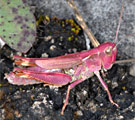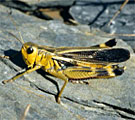Oedipoda germanica (Latreille, 1804)
![Oedipoda germanica: Male (Switzerland, Valais, Stalden, rocky steppe, mid-July 2022) [N] Oedipoda germanica: Male (Switzerland, Valais, Stalden, rocky steppe, mid-July 2022) [N]](thumbs/acrididae/germanica_im2022.jpg)
![Oedipoda germanica: Male (Greece, Peloponnese, Taygetos, early August 2019) [N] Oedipoda germanica: Male (Greece, Peloponnese, Taygetos, early August 2019) [N]](thumbs/acrididae/germanica_im2019.jpg)
![Oedipoda germanica: Male, broad black wing coloration (Greece, Peloponnese, Taygetos, early August 2019) [M] Oedipoda germanica: Male, broad black wing coloration (Greece, Peloponnese, Taygetos, early August 2019) [M]](thumbs/acrididae/germanica_9im2019.jpg)
![Oedipoda germanica: Male (Valais, Leuk, July 2019) [N] Oedipoda germanica: Male (Valais, Leuk, July 2019) [N]](thumbs/acrididae/germanica_2im2019.jpg)
![Oedipoda germanica: Female (Valais, Leuk, July 2019) [N] Oedipoda germanica: Female (Valais, Leuk, July 2019) [N]](thumbs/acrididae/germanica_3im2019.jpg)
![Oedipoda germanica: Female (Valais, Leuk, July 2019) [N] Oedipoda germanica: Female (Valais, Leuk, July 2019) [N]](thumbs/acrididae/germanica_4im2019.jpg)
![Oedipoda germanica: Female (Valais, Leuk, July 2019) [N] Oedipoda germanica: Female (Valais, Leuk, July 2019) [N]](thumbs/acrididae/germanica_5im2019.jpg)
![Oedipoda germanica: Female (Valais, Leuk, July 2019) [N] Oedipoda germanica: Female (Valais, Leuk, July 2019) [N]](thumbs/acrididae/germanica_6im2019.jpg)
![Oedipoda germanica: Female (Valais, Leuk, July 2019) [M] Oedipoda germanica: Female (Valais, Leuk, July 2019) [M]](thumbs/acrididae/germanica_7im2019.jpg)
![Oedipoda germanica: Female (Valais, Stalden, July 2019) [N] Oedipoda germanica: Female (Valais, Stalden, July 2019) [N]](thumbs/acrididae/germanica_8im2019.jpg)
![Oedipoda germanica: Male (Italy, Abruzzes, L'Aquila, Campo Felice, September 2016) [N] Oedipoda germanica: Male (Italy, Abruzzes, L'Aquila, Campo Felice, September 2016) [N]](thumbs/acrididae/germanica_im2016.jpg)
![Oedipoda germanica: Male (Valais, Switzerland, 2009) [N] Oedipoda germanica: Male (Valais, Switzerland, 2009) [N]](thumbs/acrididae/germanica_m2009.jpg)
![Oedipoda germanica: Male (Italy, Abruzzes, L'Aquila, Campo Felice, September 2016) [M] Oedipoda germanica: Male (Italy, Abruzzes, L'Aquila, Campo Felice, September 2016) [M]](thumbs/acrididae/germanica_2im2016.jpg)
![Oedipoda germanica: Male (N-Greece, Siatista, July 2010) [N] Oedipoda germanica: Male (N-Greece, Siatista, July 2010) [N]](thumbs/acrididae/germanica_3im2010.jpg)
![Oedipoda germanica: Male (SE-France, Mont Ventoux, early October 2014) [N] Oedipoda germanica: Male (SE-France, Mont Ventoux, early October 2014) [N]](thumbs/acrididae/germanica_4im2016.jpg)
![Oedipoda germanica: Adult (Valais, Switzerland, 2009) [N] Oedipoda germanica: Adult (Valais, Switzerland, 2009) [N]](thumbs/acrididae/germanica_i2009.jpg)
![Oedipoda germanica: Adult (Valais, Switzerland, 2009) [N] Oedipoda germanica: Adult (Valais, Switzerland, 2009) [N]](thumbs/acrididae/germanica_2i2009.jpg)
![Oedipoda germanica: Female (Valais, Switzerland, 2009) [N] Oedipoda germanica: Female (Valais, Switzerland, 2009) [N]](thumbs/acrididae/germanica_w2009.jpg)
![Oedipoda germanica: Male (S-Italy, Apulia, Alto Murge, early October 2023) [N] Oedipoda germanica: Male (S-Italy, Apulia, Alto Murge, early October 2023) [N]](thumbs/acrididae/germanica_im2023.jpg)
![Oedipoda germanica: Male (S-Italy, Apulia, Alto Murge, early October 2023) [N] Oedipoda germanica: Male (S-Italy, Apulia, Alto Murge, early October 2023) [N]](thumbs/acrididae/germanica_2im2023.jpg)
![Oedipoda germanica: Male (S-Italy, Apulia, Alto Murge, early October 2023) [N] Oedipoda germanica: Male (S-Italy, Apulia, Alto Murge, early October 2023) [N]](thumbs/acrididae/germanica_3im2023.jpg)
![Oedipoda germanica: Male (S-Italy, Apulia, Alto Murge, early October 2023) [N] Oedipoda germanica: Male (S-Italy, Apulia, Alto Murge, early October 2023) [N]](thumbs/acrididae/germanica_4im2023.jpg)
![Oedipoda germanica: Male (S-Italy, Apulia, Alto Murge, early October 2023) [M] Oedipoda germanica: Male (S-Italy, Apulia, Alto Murge, early October 2023) [M]](thumbs/acrididae/germanica_5im2023.jpg)
![Oedipoda germanica: Male (S-Italy, Apulia, Alto Murge, early October 2023) [M] Oedipoda germanica: Male (S-Italy, Apulia, Alto Murge, early October 2023) [M]](thumbs/acrididae/germanica_6im2023.jpg)
![Oedipoda germanica: Male (S-Italy, Apulia, Alto Murge, early October 2023) [M] Oedipoda germanica: Male (S-Italy, Apulia, Alto Murge, early October 2023) [M]](thumbs/acrididae/germanica_7im2023.jpg)
![Oedipoda germanica: Male (S-Italy, Apulia, Alto Murge, early October 2023) [M] Oedipoda germanica: Male (S-Italy, Apulia, Alto Murge, early October 2023) [M]](thumbs/acrididae/germanica_8im2023.jpg)
![Oedipoda germanica: Male (S-Italy, Apulia, Alto Murge, early October 2023) [M] Oedipoda germanica: Male (S-Italy, Apulia, Alto Murge, early October 2023) [M]](thumbs/acrididae/germanica_9im2023.jpg)
![Oedipoda germanica: Female (S-Italy, Apulia, Alto Murge, early October 2023) [N] Oedipoda germanica: Female (S-Italy, Apulia, Alto Murge, early October 2023) [N]](thumbs/acrididae/germanica_10im2023.jpg)
![Oedipoda germanica: Female (S-Italy, Apulia, Alto Murge, early October 2023) [N] Oedipoda germanica: Female (S-Italy, Apulia, Alto Murge, early October 2023) [N]](thumbs/acrididae/germanica_11im2023.jpg)
![Oedipoda germanica: Female (S-Italy, Apulia, Alto Murge, early October 2023) [N] Oedipoda germanica: Female (S-Italy, Apulia, Alto Murge, early October 2023) [N]](thumbs/acrididae/germanica_12im2023.jpg)
![Oedipoda germanica: Female (S-Italy, Apulia, Alto Murge, early October 2023) [N] Oedipoda germanica: Female (S-Italy, Apulia, Alto Murge, early October 2023) [N]](thumbs/acrididae/germanica_13im2023.jpg)
![Oedipoda germanica: Female (S-Italy, Apulia, Alto Murge, early October 2023) [N] Oedipoda germanica: Female (S-Italy, Apulia, Alto Murge, early October 2023) [N]](thumbs/acrididae/germanica_14im2023.jpg)
![Oedipoda germanica: Female (S-Italy, Apulia, Alto Murge, early October 2023) [N] Oedipoda germanica: Female (S-Italy, Apulia, Alto Murge, early October 2023) [N]](thumbs/acrididae/germanica_15im2023.jpg)
![Oedipoda germanica: Female (S-Italy, Apulia, Alto Murge, early October 2023) [N] Oedipoda germanica: Female (S-Italy, Apulia, Alto Murge, early October 2023) [N]](thumbs/acrididae/germanica_16im2023.jpg)
![Oedipoda germanica: Female (S-Italy, Apulia, Alto Murge, early October 2023) [M] Oedipoda germanica: Female (S-Italy, Apulia, Alto Murge, early October 2023) [M]](thumbs/acrididae/germanica_17im2023.jpg)
![Oedipoda germanica: Female (S-Italy, Apulia, Alto Murge, early October 2023) [M] Oedipoda germanica: Female (S-Italy, Apulia, Alto Murge, early October 2023) [M]](thumbs/acrididae/germanica_18im2023.jpg)
![Oedipoda germanica: Female (S-Italy, Apulia, Alto Murge, early October 2023) [M] Oedipoda germanica: Female (S-Italy, Apulia, Alto Murge, early October 2023) [M]](thumbs/acrididae/germanica_19im2023.jpg)
![Oedipoda germanica: Female (Italy, Monte Sibilla, early October 2023) [N] Oedipoda germanica: Female (Italy, Monte Sibilla, early October 2023) [N]](thumbs/acrididae/germanica_20im2023.jpg)
![Oedipoda germanica: Female (Italy, Monte Sibilla, early October 2023) [N] Oedipoda germanica: Female (Italy, Monte Sibilla, early October 2023) [N]](thumbs/acrididae/germanica_21im2023.jpg)
![Oedipoda germanica: Female (Italy, Monte Sibilla, early October 2023) [M] Oedipoda germanica: Female (Italy, Monte Sibilla, early October 2023) [M]](thumbs/acrididae/germanica_22im2023.jpg)
![Oedipoda germanica: Male (Italy, Monti Reatini, Monte Terminillo, early October 2023) [N] Oedipoda germanica: Male (Italy, Monti Reatini, Monte Terminillo, early October 2023) [N]](thumbs/acrididae/germanica_23im2023.jpg)
![Oedipoda germanica: Male (Ipf near Bopfingen, South Germany, in 2000) [N] Oedipoda germanica: Male (Ipf near Bopfingen, South Germany, in 2000) [N]](thumbs/acrididae/germanica_m1.jpg)
![Oedipoda germanica: Female (Ipf near Bopfingen, 2000) [N] Oedipoda germanica: Female (Ipf near Bopfingen, 2000) [N]](thumbs/acrididae/germanica_w.jpg)
![Oedipoda germanica: Courtship (2000, SW-Germany, Ipf near Bopfingen) [N] Oedipoda germanica: Courtship (2000, SW-Germany, Ipf near Bopfingen) [N]](thumbs/acrididae/germanica_balz.jpg)
![Oedipoda germanica: Habitat in the Haute-Provence, France [N] Oedipoda germanica: Habitat in the Haute-Provence, France [N]](thumbs/acrididae/germanica_h.jpg)
![Oedipoda germanica: Habitat in the Swiss Valais in the spring [N] Oedipoda germanica: Habitat in the Swiss Valais in the spring [N]](thumbs/acrididae/germanica_h2009.jpg)
![Oedipoda germanica: Habitat (Valais, Leuk, July 2019) [N] Oedipoda germanica: Habitat (Valais, Leuk, July 2019) [N]](thumbs/acrididae/germanica_h2019.jpg)
![Oedipoda germanica: Habitat (Valais, Leuk, July 2019) [N] Oedipoda germanica: Habitat (Valais, Leuk, July 2019) [N]](thumbs/acrididae/germanica_2h2019.jpg)
![Oedipoda germanica: Habitat (S-Italy, Apulia, Alto Murge, early October 2023) [N] Oedipoda germanica: Habitat (S-Italy, Apulia, Alto Murge, early October 2023) [N]](thumbs/acrididae/germanica_h2023.jpg)
![Oedipoda germanica: Habitat (Italy, Monti Reatini, Monte Terminillo, early October 2023) [N] Oedipoda germanica: Habitat (Italy, Monti Reatini, Monte Terminillo, early October 2023) [N]](thumbs/acrididae/germanica_2h2023.jpg)
![Oedipoda germanica: Habitat (Italy, Monte Sibilla, early October 2023) [N] Oedipoda germanica: Habitat (Italy, Monte Sibilla, early October 2023) [N]](thumbs/acrididae/germanica_3h2023.jpg)
![Oedipoda germanica: Habitat (Italy, Monte Sibilla, early October 2023) [N] Oedipoda germanica: Habitat (Italy, Monte Sibilla, early October 2023) [N]](thumbs/acrididae/germanica_4h2023.jpg)
Nutrition:
The species feeds on herbs, more rarely grasses, mosses and lichens. More often it is observed also on carrion like dead insects.
Habitat:
Oedipoda germanica colonizes rocky grasslands with xerothermous microclimate and many open spoil spots. Oedipoda germanica is ascending in the southern central Alps higher than Oedipoda caerulescens, namely to about 2500m above sea level (the former only to about 2100m above sea level). The insects lacks like Oedipoda caerulescens in the northern Alps and is limited north of the Alps to the lowlands and lower mountain ranges.
Life cycle:
Adults occur from the end of June to October (even at 2300 meters above sea level often still in mid-October, if no stronger frosts occurred). Eggs are laid into loose soil.
Endangerment: threatened with extinction
Endangerment factors:
In southern Europe and the southern and central part (Valais) of the Alps, Oedipoda germanica is still widespread and often abundant. In Germany however, it is threatened with extinction, and dwindled to tiny remnants. Almost all localities are already gone, so probably the last site on the edge of the Swabian Alb (Ipf), where I saw in 2000 the probably last adults (see photos). Causes are the reduction and deterioration of the habitats of this demanding species: decline in open soil spots by eutrophication, grazing decline, bush encroachment, reforestation of adjacent land, overbuilding/road construction, trivialization by excessive tourism (walking on rocky tips, climbing), isolation of the last populations, mining of stones, gravel etc. (but which can also lead to good secondary habitats if suitable implemented in appropriate locations), intensification and expansion of viticulture with removal of old walls and giant terraces). Poor summers then do the rest with individual-weak remnant populations.
Remarks:
Oedipoda germanica occurs from the Pyrenees across parts of central and southern Europe (to the north app. to the central German lower mountain ranges, to the south to central Italy and southern Greece) and Asia Minor to southern Russia.
Oedipoda aurea | Oedipoda caerulescens | Oedipoda canariensis | Oedipoda charpentieri | Oedipoda coerulea | Oedipoda cynthiae | Oedipoda fuscocincta | Oedipoda miniata


